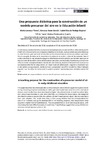Mostrar o rexistro simple do ítem
Una propuesta didáctica para la construcción de un modelo precursor del aire en la Educación Infantil
| dc.contributor.author | Lorenzo Flores, María | |
| dc.contributor.author | Sesto, Vanessa | |
| dc.contributor.author | García-Rodeja Gayoso, Isabel | |
| dc.date.accessioned | 2019-02-18T13:12:29Z | |
| dc.date.available | 2019-02-18T13:12:29Z | |
| dc.date.issued | 2018 | |
| dc.identifier.citation | Ápice. Revista de Educación Científica, 2018,2, 2: 55-68. ISSN: 2531-016X | es_ES |
| dc.identifier.issn | 2531-016X | |
| dc.identifier.uri | http://hdl.handle.net/2183/21836 | |
| dc.description.abstract | [Resumen] En este trabajo se describe cómo evolucionan las explicaciones de catorce niños y niñas de Educación Infantil (3-5 años) durante una propuesta didáctica sobre el aire. Aunque existe una vasta literatura en este dominio, gran parte de los estudios se han desarrollado en etapas educativas superiores. Para la recogida de datos se ha recurrido a la grabación en audio y vídeo de las sesiones. Para el análisis de datos se han adoptado categorías descritas en estudios previos que también abordan las explicaciones de los niños acerca de fenómenos naturales. Los resultados muestran que al inicio los niños no tenían conceptualizada la idea de aire. Sin embargo, durante el desarrollo de la secuencia sus explicaciones fueron adquiriendo un mayor nivel de sofisticación. Llegaron a reconocer que el aire existe y ocupa espacio, siendo la masa la propiedad más difícil de asimilar. Estos hallazgos sugieren que los niños de corta edad sí pueden construir representaciones mentales acerca del aire. | es_ES |
| dc.description.abstract | [Abstract] This paper describes how the explanations of fourteen pre-school children (aged 3 to 5 years) evolve during a teaching proposal concerning air. Although there is extensive research on this conceptual domain, most studies have been developed at higher educational levels. In order to collect data, each session was recorded in audio and video files. As a method for data analysis, the categories described in previous studies that also address children’s explanations about natural phenomena have been adopted. The results show that, at first, young children had not conceptualized the idea of air. However, during the development of the teaching proposal, their explanations were acquiring a higher level of sophistication. They recognized that air exists and occupies space, with mass being the most difficult property to assimilate. These findings suggest that young children can construct mental representations of air | es_ES |
| dc.language.iso | spa | es_ES |
| dc.rights | Atribución-CompartirIgual 3.0 España | es_ES |
| dc.rights.uri | http://creativecommons.org/licenses/by-sa/3.0/es/ | * |
| dc.subject | Aire | es_ES |
| dc.subject | Propuesta didáctica | es_ES |
| dc.subject | Educación infantil | es_ES |
| dc.subject | Explicación | es_ES |
| dc.subject | Modelo precursor | es_ES |
| dc.subject | Air | es_ES |
| dc.subject | Teaching proposal | es_ES |
| dc.subject | Early childhood education | es_ES |
| dc.subject | Explanation | es_ES |
| dc.subject | Precursor model | es_ES |
| dc.title | Una propuesta didáctica para la construcción de un modelo precursor del aire en la Educación Infantil | es_ES |
| dc.title.alternative | A teaching proposal for the construction of a precursor model of air in early childhood education | es_ES |
| dc.type | info:eu-repo/semantics/article | es_ES |
| dc.rights.access | info:eu-repo/semantics/openAccess | es_ES |
| UDC.journalTitle | Ápice. Revista de Educación Científica | es_ES |
| UDC.volume | 2 | es_ES |
| UDC.issue | 2 | es_ES |
| UDC.startPage | 55 | es_ES |
| UDC.endPage | 68 | es_ES |
| dc.identifier.doi | https://doi.org/10.17979/arec.2018.2.2.4628 |






